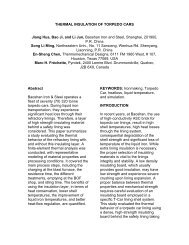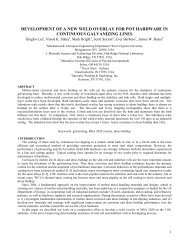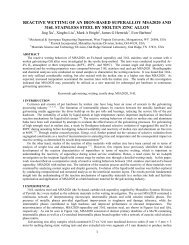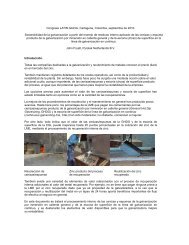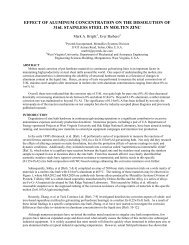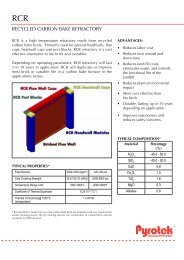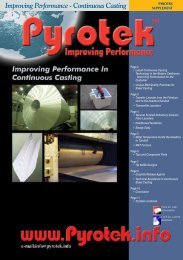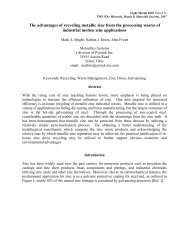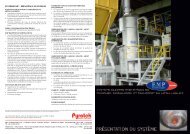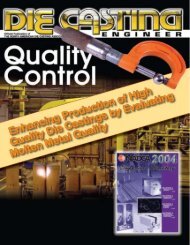improving performance in furnace melt treatment process - Pyrotek
improving performance in furnace melt treatment process - Pyrotek
improving performance in furnace melt treatment process - Pyrotek
Create successful ePaper yourself
Turn your PDF publications into a flip-book with our unique Google optimized e-Paper software.
In-Furnace Melt Treatment Process<br />
PYROTEK<br />
SUPPLEMENT
Jonathan Prebble,<br />
<strong>Pyrotek</strong>’s Manager of<br />
Alum<strong>in</strong>ium Process<br />
Technology<br />
In-Furnace Melt Treatment Process<br />
<strong>Pyrotek</strong> has<br />
the expertise,<br />
technology,<br />
experience<br />
and the<br />
global<br />
resources to<br />
maximize the<br />
<strong>performance</strong><br />
of your<br />
alum<strong>in</strong>ium<br />
<strong>melt</strong><br />
<strong>treatment</strong><br />
systems.<br />
Page 2<br />
PYROTEK<br />
SUPPLEMENT<br />
IMPROVING PERFORMANCE IN<br />
FURNACE MELT TREATMENT PROCESS<br />
ANALYZING THE MELT<br />
TREATMENT PROCESS<br />
Quality is generally def<strong>in</strong>ed as<br />
conformance to mutually agreed upon<br />
customer specifications. This def<strong>in</strong>ition<br />
matches well with any discussion around<br />
alum<strong>in</strong>ium <strong>melt</strong> quality and the related<br />
molten metal <strong>treatment</strong> <strong>process</strong>. The <strong>melt</strong><br />
<strong>treatment</strong> <strong>process</strong>es addressed <strong>in</strong> this<br />
article <strong>in</strong>clude alloy<strong>in</strong>g and <strong>furnace</strong> <strong>melt</strong><br />
ref<strong>in</strong><strong>in</strong>g. In-l<strong>in</strong>e degass<strong>in</strong>g and filtration,<br />
which are important components <strong>in</strong><br />
achiev<strong>in</strong>g f<strong>in</strong>al <strong>melt</strong> quality, will be<br />
addressed separately <strong>in</strong> the next article <strong>in</strong><br />
this series titled, “Improv<strong>in</strong>g Performance –<br />
Degass<strong>in</strong>g and Filtration Processes.”<br />
The five ma<strong>in</strong> <strong>melt</strong> quality culprits for the<br />
casthouse are the follow<strong>in</strong>g:<br />
Trace elements, caus<strong>in</strong>g off specification<br />
or <strong>in</strong>consistent casts.<br />
Alkali metals, caus<strong>in</strong>g crack<strong>in</strong>g and<br />
missed specifications.<br />
Hydrogen, caus<strong>in</strong>g porosity and density<br />
compla<strong>in</strong>ts.<br />
Inclusions, caus<strong>in</strong>g downstream<br />
<strong>process</strong><strong>in</strong>g complications.<br />
Product <strong>in</strong>consistency due to either<br />
chemical or thermal variations dur<strong>in</strong>g<br />
cast<strong>in</strong>g.<br />
The <strong>process</strong> of <strong>melt</strong> <strong>treatment</strong> starts with the<br />
requirements of the f<strong>in</strong>ished product’s enduser.<br />
These requirements vary widely and<br />
need to be understood, agreed upon and<br />
documented so that <strong>melt</strong> quality <strong>process</strong>es<br />
can be managed to deliver this specification<br />
with zero defects at the lowest possible<br />
cost. While it starts with consistently<br />
meet<strong>in</strong>g customer specifications, it does not<br />
end there. Other critical factors <strong>in</strong> manag<strong>in</strong>g<br />
<strong>melt</strong> quality <strong>process</strong>es <strong>in</strong>clude operational<br />
costs/cycle times, operational health and<br />
safety, and environmental impact/<br />
compliance.<br />
To maximize casthouse <strong>performance</strong> <strong>in</strong> all<br />
these critical areas, it is important that the<br />
production team clearly understands the<br />
market<strong>in</strong>g and operational objectives<br />
<strong>in</strong>volved. These def<strong>in</strong>ed objectives measure<br />
the effectiveness of the <strong>melt</strong> quality<br />
<strong>process</strong>es and practices upon the f<strong>in</strong>al cast<br />
product. Typical challenges <strong>in</strong>clude, but are<br />
not limited to, how to achieve the same<br />
level of product quality consistency time <strong>in</strong><br />
and time out, comb<strong>in</strong>ed with how to achieve<br />
optimum <strong>performance</strong> <strong>in</strong> a practical<br />
manner while, at the same time, m<strong>in</strong>imiz<strong>in</strong>g<br />
costs and maximiz<strong>in</strong>g productivity.<br />
These challenges and issues vary greatly<br />
depend<strong>in</strong>g upon whether <strong>process</strong><strong>in</strong>g<br />
primary or secondary metals. It is important<br />
to understand the <strong>melt</strong> quality and source<br />
of impurities at the beg<strong>in</strong>n<strong>in</strong>g of the cast<strong>in</strong>g<br />
<strong>process</strong> <strong>in</strong> order to establish successful<br />
operational <strong>process</strong>es that will deliver<br />
consistent metal quality to the cast<strong>in</strong>g<br />
station.<br />
<strong>Pyrotek</strong>’s mission is to work with casthouse<br />
managers to develop a coord<strong>in</strong>ated, holistic<br />
approach to a susta<strong>in</strong>able operations plan<br />
for <strong>melt</strong> <strong>treatment</strong>. We br<strong>in</strong>g all these<br />
operational elements together <strong>in</strong> a<br />
synergistic way that maximizes the<br />
<strong>performance</strong> of each step of the <strong>melt</strong><br />
<strong>treatment</strong> <strong>process</strong>. <strong>Pyrotek</strong>’s approach<br />
<strong>in</strong>cludes a <strong>process</strong> audit and situation<br />
analysis with the customer to jo<strong>in</strong>tly<br />
understand and document the customer’s<br />
operational objectives, historical operat<strong>in</strong>g<br />
<strong>performance</strong>, cast<strong>in</strong>g pit capabilities, end<br />
user requirements, environmental<br />
objectives and safety. Once these are<br />
understood and agreed upon, a prioritized<br />
list of <strong>performance</strong> improvement projects<br />
(PIP’s) are identified. A <strong>Pyrotek</strong> technical<br />
team is then organized to work with the<br />
customer to execute, track and evaluate<br />
each project’s results aga<strong>in</strong>st preestablished<br />
targets and world-class<br />
operational norms for similar operations,<br />
target<strong>in</strong>g similar <strong>melt</strong> quality specifications.
In-Furnace Melt Treatment Process<br />
PRIMARY VS. SECONDARY<br />
What are the different impurities?<br />
Primary s<strong>melt</strong><strong>in</strong>g can <strong>in</strong>troduce the<br />
follow<strong>in</strong>g impurities:<br />
From the ref<strong>in</strong>ed alum<strong>in</strong>a we obta<strong>in</strong><br />
elements such as Si, Fe, and traces of Ti,<br />
Ca, V, B, etc.<br />
From the coke blend used to make the<br />
anodes we pick up further traces of Ti, V,<br />
Ca, Si, Fe, etc.<br />
From the carbon plant operations, we<br />
attract traces of Si, P, Fe, Mn – ma<strong>in</strong>ly from<br />
the anode but also from the cast iron<br />
thimbles and the steel stubs on the anode<br />
rod assemblies.<br />
Recycled Secondary Ingot (RSI)<br />
Dissolution of these impurities takes place<br />
<strong>in</strong> the cell/pot at ~ 960°C. The chemical bath<br />
also contributes alkali metals from the salts<br />
used – K, Na, Ca and Li. Some cells operate<br />
a high Li bath chemistry for added current<br />
efficiency. Carbides and oxides are also<br />
generated by the turbulent electro-magnetic<br />
and chemical activity <strong>in</strong> the cells and the<br />
reactions with the cell l<strong>in</strong><strong>in</strong>g materials. The<br />
bath is frequently tapped along with the<br />
metal <strong>in</strong> the crucible delivered to the cast<br />
house. Turbulence dur<strong>in</strong>g the transfer leads<br />
to oxide and dross <strong>in</strong>clusions <strong>in</strong> the metal.<br />
Refractory wear <strong>in</strong> transfer ladles also leads<br />
to a risk of <strong>in</strong>creased <strong>in</strong>clusions.<br />
Feed stock from secondary <strong>melt</strong><strong>in</strong>g can<br />
<strong>in</strong>troduce an even wider range of impurities<br />
depend<strong>in</strong>g on the material comb<strong>in</strong>ation<br />
used to charge the <strong>furnace</strong>. Recycled<br />
Secondary Ingot (RSI) cast from metal<br />
recovered from dross, saw chips, saw f<strong>in</strong>es<br />
and thermal fill scrap, can contribute alkali<br />
metals as well as TiB and alum<strong>in</strong>ium<br />
2<br />
oxides. Recycled scrap from <strong>in</strong>ternal or<br />
external sources is an additional source of<br />
hydrocarbons, pa<strong>in</strong>ts, lacquers,<br />
surface <strong>treatment</strong>s, oils and<br />
lubricants. Fumes, diox<strong>in</strong>s and<br />
furans can be produced <strong>in</strong> large<br />
amounts depend<strong>in</strong>g on the quality<br />
and quantity of recycled material<br />
that is <strong>melt</strong>ed. Customer returns<br />
and <strong>in</strong>-house scrap can add Li and<br />
Zn <strong>in</strong> 7000 series, Cu <strong>in</strong> 2000<br />
series, Mn <strong>in</strong> 3000 series, Si <strong>in</strong><br />
4000 series, Mg <strong>in</strong> 5000 series and<br />
Fe <strong>in</strong> 8000 series.<br />
Alloy<strong>in</strong>g elements such as silicon<br />
can <strong>in</strong>troduce dusts, as well as<br />
high levels of iron and calcium.<br />
These can be slowly absorbed <strong>in</strong>to<br />
the solution. Magnesium additions<br />
can contribute magnesium oxide,<br />
Fe and Ca. Boron waffle, when<br />
added to the <strong>furnace</strong> for EC<br />
grades, fades <strong>in</strong> as little as 90<br />
m<strong>in</strong>utes develop<strong>in</strong>g <strong>in</strong>to TiB , 2<br />
which settles and turns the<br />
<strong>furnace</strong> bottom <strong>in</strong>to a sticky<br />
sludge. Tibor rod, when added to<br />
the trough outside the <strong>furnace</strong> <strong>in</strong><br />
route to the cast<strong>in</strong>g table, can<br />
have a tendency not to mix well<br />
<strong>in</strong> the trough, develop<strong>in</strong>g <strong>in</strong>to<br />
coarse TiB particles, which can<br />
2<br />
affect degass<strong>in</strong>g efficiency and/or<br />
clog the downstream filtration<br />
systems <strong>in</strong> use.<br />
PYROTEK<br />
SUPPLEMENT<br />
SECONDARY SOURCES<br />
OF IMPURITIES<br />
Recycled Scrap<br />
Purchased Scrap<br />
Uncoated Metal Tools<br />
Process<strong>in</strong>g practices are a<br />
constant source of contam<strong>in</strong>ates.<br />
Poor handl<strong>in</strong>g and metal flow Inefficient or Poorly Adjusted<br />
arrangements generate metal Burners<br />
turbulence, which <strong>in</strong> turn,<br />
generates dross and oxides. Iron pick up can<br />
come from uncoated metal tools. Poor<br />
housekeep<strong>in</strong>g allows dirt, <strong>in</strong>clusions and<br />
dusts to become entra<strong>in</strong>ed <strong>in</strong> the metal flow<br />
as <strong>in</strong>clusions to the next cast. Waste burner<br />
gases and poor burner efficiency allow<br />
hydrogen to be absorbed. Open doors and/<br />
or improper burner adjustments can<br />
contribute to hydrogen pickup and to <strong>melt</strong><br />
loss due to direct flame imp<strong>in</strong>gement. In-l<strong>in</strong>e<br />
degass<strong>in</strong>g can be an un<strong>in</strong>tentional source<br />
of contam<strong>in</strong>ates from rotor speed too slow<br />
(large bubbles), rotor speed too fast<br />
(vortex<strong>in</strong>g), rotor particulate, oxide build up<br />
and broken baffle plates.<br />
Page 3
Alan Peel,<br />
Manag<strong>in</strong>g Director<br />
EMP Division<br />
Page 4<br />
In-Furnace Melt Treatment Process<br />
Purchas<strong>in</strong>g<br />
pure<br />
alloy elements<br />
<strong>in</strong> a form<br />
that can be<br />
charged<br />
directly<br />
<strong>in</strong>to the<br />
vortex of an<br />
EMP System<br />
also can give<br />
some<br />
f<strong>in</strong>ancial<br />
benefits.<br />
ALLOYING - A Critical First Step<br />
In Improv<strong>in</strong>g Melt Treatment<br />
Performance<br />
Alloy<strong>in</strong>g is the modification of <strong>melt</strong><br />
chemistry to meet cast<strong>in</strong>g specifications. It<br />
is typically done <strong>in</strong> the <strong>melt</strong><strong>in</strong>g <strong>furnace</strong> and<br />
adjusted <strong>in</strong> the hold<strong>in</strong>g <strong>furnace</strong>s or dur<strong>in</strong>g<br />
transfer. Alloy<strong>in</strong>g elements <strong>in</strong>clude, but are<br />
not limited to: silicon, iron, magnesium,<br />
manganese, copper and chromium. Stirr<strong>in</strong>g<br />
and <strong>melt</strong> homogenization are key<br />
components of the alloy<strong>in</strong>g <strong>process</strong>.<br />
Alloy<strong>in</strong>g cycle times must allow for<br />
adequate dissolution time as well as for the<br />
time required to complete proper <strong>furnace</strong><br />
skimm<strong>in</strong>g, ref<strong>in</strong><strong>in</strong>g and settl<strong>in</strong>g. For certa<strong>in</strong><br />
applications, there is a need to select highgrade<br />
alloys (for example, low Fe and Ca<br />
silicon metal for wheel/rim alloys).<br />
To maximize efficiency, operat<strong>in</strong>g practices<br />
must measure alloy<strong>in</strong>g recoveries, adjust<br />
<strong>furnace</strong> temperatures and <strong>process</strong><strong>in</strong>g<br />
techniques to optimise alloy additions. If<br />
operat<strong>in</strong>g <strong>in</strong> conjunction with a primary<br />
s<strong>melt</strong>er, it is often possible to utilise the hot<br />
metal superheat – a potential source of free<br />
<strong>furnace</strong> energy. Use powders, flakes and<br />
tablets rather than <strong>in</strong>got or waffle to reduce<br />
energy costs and to accelerate dissolution<br />
rates when they can be efficiently stirred<br />
<strong>in</strong>to the metal.<br />
The use of effective techniques to facilitate<br />
forced circulation of the <strong>melt</strong> dur<strong>in</strong>g the<br />
<strong>melt</strong><strong>in</strong>g and alloy<strong>in</strong>g phases of the <strong>process</strong><br />
demonstrates improvements <strong>in</strong> cycle times<br />
and more efficient use of expensive alloy<strong>in</strong>g<br />
materials.<br />
The EMP and Metaullics division both offer<br />
the LOTUSS vortex system which is a<br />
highly effective method of submergence for<br />
both scrap and alloy<strong>in</strong>g materials.<br />
Traditional methods for alloy<strong>in</strong>g <strong>in</strong> the cast<br />
house utilized pre-prepared master alloys.<br />
These are charged directly <strong>in</strong>to the <strong>melt</strong><strong>in</strong>g<br />
or hold<strong>in</strong>g <strong>furnace</strong> and ‘stirred <strong>in</strong>’ with the<br />
assistance of the dross rake. The problem<br />
associated with this technique is that it tends<br />
to take longer for the alloy addition to<br />
become fully mixed <strong>in</strong>to the <strong>melt</strong> as the<br />
mix<strong>in</strong>g is reliant upon the dross<strong>in</strong>g tool to<br />
PYROTEK<br />
SUPPLEMENT<br />
fully mix the bath and master alloys. In an<br />
attempt to overcome this problem of<br />
effective mix<strong>in</strong>g, the master alloys are<br />
usually made with a special flux that<br />
accelerates the mix<strong>in</strong>g of the alloy addition<br />
<strong>in</strong>to the <strong>melt</strong>.<br />
The EMP and Metaullics pump<strong>in</strong>g systems<br />
for light gauge scrap additions have the<br />
advantage of the unique vortex well as a<br />
medium for the addition of alloys <strong>in</strong>to the<br />
<strong>furnace</strong>. The <strong>furnace</strong> door is kept closed<br />
dur<strong>in</strong>g the entire <strong>process</strong>, with the follow<strong>in</strong>g<br />
three operat<strong>in</strong>g benefits:<br />
Ma<strong>in</strong>ta<strong>in</strong><strong>in</strong>g the heat transfer efficiency<br />
of the <strong>furnace</strong>,<br />
M<strong>in</strong>imis<strong>in</strong>g energy losses, and<br />
M<strong>in</strong>imis<strong>in</strong>g environmental emissions to<br />
the casthouse and operators.<br />
The LOTUSS vortex system elim<strong>in</strong>ates the<br />
need to alloy directly through the <strong>furnace</strong><br />
doors or by us<strong>in</strong>g specially made alloy<br />
tablets. The pure elemental additions Mn<br />
flake, Fe splatter, Cu cutt<strong>in</strong>gs/swarf and Mg<br />
bars can now be used <strong>in</strong> an effective way<br />
by charg<strong>in</strong>g directly through the EMP<br />
Vortex.<br />
Fig. 1 Magnesium Ingots Charged Directly Into<br />
the EMP Vortex<br />
Economic Benefits to Alloy<strong>in</strong>g Through<br />
The Vortex<br />
With the appropriate feed<strong>in</strong>g equipment,<br />
alloys from lump silicon to magnesium have<br />
been effectively charged <strong>in</strong>to a <strong>furnace</strong> with<br />
significant reductions <strong>in</strong> alloy losses and an<br />
improved dissolution time of the alloy <strong>in</strong>to<br />
the <strong>melt</strong>.<br />
The follow<strong>in</strong>g graph demonstrates the fast<br />
dissolution of magnesium <strong>in</strong>gots through a<br />
vortex.
In-Furnace Melt Treatment Process<br />
Fig. 2 Chemical Homogeneity<br />
Yield Improvement<br />
This reduction <strong>in</strong> alloy losses results from the<br />
fact that the alloy addition is immediately<br />
submerged sub-surface, m<strong>in</strong>imis<strong>in</strong>g any<br />
exposure to the air and to the burners <strong>in</strong> the<br />
<strong>furnace</strong>. Typical yields on pure alloy additions<br />
charged <strong>in</strong> this manner are shown below:<br />
Alloy Yield By Yield When<br />
Addition Charg<strong>in</strong>g Charged Directly<br />
Through EMP To Furnace<br />
Lump Silicon 97% 94%<br />
Magnesium 98% 90%<br />
10 Kg Ingot<br />
Manganese Flake 98% 94%<br />
Iron Splatter 98% 90%<br />
(Powder/Tablet)<br />
Copper 99% Only Tablets<br />
Yield Improvement by Charg<strong>in</strong>g Pure<br />
Alloys Directly Into EMP Vortex<br />
Reduced Mix<strong>in</strong>g Time<br />
By charg<strong>in</strong>g the alloy additions <strong>in</strong> this<br />
manner, they are immediately mixed <strong>in</strong> the<br />
sub-surface alum<strong>in</strong>ium movement with<strong>in</strong> the<br />
vortex. They quickly dissolve and are easily<br />
mixed <strong>in</strong>to the full alum<strong>in</strong>ium bath by the<br />
rapid sub-surface flow from the<br />
electromagnetic pump.<br />
Alloy Purchase Costs<br />
Purchas<strong>in</strong>g pure alloy elements <strong>in</strong> a form that<br />
can be charged directly <strong>in</strong>to the vortex of an<br />
EMP System also can give some f<strong>in</strong>ancial<br />
benefits. Normally it is not possible to use<br />
pure additions when charg<strong>in</strong>g directly <strong>in</strong>to<br />
the <strong>furnace</strong> due to their ability to go <strong>in</strong>to<br />
solution. The yield can also be a concern as<br />
they tend to be small <strong>in</strong> size and oxidise<br />
easily.<br />
By us<strong>in</strong>g the LOTUSS vortex well, it<br />
becomes practical to charge these pure<br />
elemental additions directly through the<br />
vortex. The result is a yield that is much<br />
higher (depend<strong>in</strong>g upon the quality of the<br />
alloy oil, moisture levels etc.) than when<br />
charg<strong>in</strong>g through the ma<strong>in</strong> <strong>furnace</strong> door.<br />
The use of pure elements offers additional<br />
sav<strong>in</strong>gs <strong>in</strong> the reduced cost of master<br />
alloys and tablets.<br />
Additional Benefits of EMP Systems<br />
EMP now offers complete solutions to<br />
<strong>melt</strong><strong>in</strong>g <strong>furnace</strong> problems. EMP’s use of a<br />
LOTUSS charge well offers casthouse<br />
operations the follow<strong>in</strong>g opportunities:<br />
Reduced alloy<strong>in</strong>g costs<br />
Ability to transfer from <strong>furnace</strong> to<br />
<strong>furnace</strong> or to cast<strong>in</strong>g l<strong>in</strong>es<br />
Option to raise metal levels for transfer<br />
Add flux additions directly <strong>in</strong>to the <strong>melt</strong><br />
Reduced emissions when flux<strong>in</strong>g<br />
Improved flux efficiency for Na and Ca<br />
removal<br />
Capability to <strong>in</strong>corporate gas <strong>in</strong>jection<br />
for hydrogen removal.<br />
LOTUSS (Low Turbulence<br />
Scrap Submergence System)<br />
The LOTUSS (Low Turbulence Scrap<br />
Submergence System) <strong>in</strong> conjunction with<br />
a Metaullics mechanical pump or EMP<br />
electromagnetic pump, has proven<br />
especially effective for submerg<strong>in</strong>g and<br />
blend<strong>in</strong>g silicon alloy additions and light<br />
gauge scrap such as mach<strong>in</strong><strong>in</strong>g chips,<br />
turn<strong>in</strong>gs, bor<strong>in</strong>gs or “swarf” exhibit<strong>in</strong>g a<br />
high surface-area-to-weight ratio.<br />
Typically, these types of materials <strong>in</strong>clude<br />
oxides, lubricants and debris created<br />
dur<strong>in</strong>g the production <strong>process</strong>. The<br />
propensity for alum<strong>in</strong>ium to oxidise<br />
<strong>in</strong>creases the metal surface tension,<br />
caus<strong>in</strong>g light gauge charge materials to<br />
rema<strong>in</strong> on the surface of the molten metal.<br />
This causes further oxidation and<br />
subsequent <strong>melt</strong> loss. The use of a forced<br />
submergence technology, like<br />
the LOTUSS system,<br />
greatly reduces this effect,<br />
permitt<strong>in</strong>g high metal<br />
yield rates and <strong>in</strong>creased<br />
productivity.<br />
Metaullics Tensor ® Circulation Pump <strong>in</strong> Comb<strong>in</strong>ation<br />
With a LOTUSS Charg<strong>in</strong>g System<br />
PYROTEK<br />
SUPPLEMENT<br />
Dave Plant,<br />
Project Eng<strong>in</strong>eer<br />
EMP Division<br />
<strong>Pyrotek</strong>’s<br />
EMP,<br />
Metaullics<br />
and<br />
SNIF ®<br />
divisions<br />
offer a<br />
complete<br />
l<strong>in</strong>e of<br />
circulation<br />
equipment.<br />
Page 5
Paul Campbell<br />
Market<strong>in</strong>g Manager<br />
Metaullics Systems<br />
Division<br />
In-Furnace Melt Treatment Process<br />
The<br />
Metaullics<br />
gas <strong>in</strong>jection<br />
pump is the<br />
product of<br />
choice<br />
where<br />
demagg<strong>in</strong>g is<br />
required.<br />
Page 6<br />
DEMAGGING WITH CHLORINE<br />
In order to produce foundry alloys,<br />
secondary s<strong>melt</strong>ers often use chlor<strong>in</strong>e gas<br />
to demag, degas, or both. Foundry alloys<br />
for sand, permanent mold, and die cast<strong>in</strong>g<br />
require low magnesium levels. Wrought<br />
alloys such as build<strong>in</strong>g materials,<br />
extrusions, beverage conta<strong>in</strong>ers,<br />
and a wide variety of other<br />
commonly recycled consumer<br />
products conta<strong>in</strong> substantially high<br />
levels of magnesium. To the extent<br />
possible, scrap is often blended<br />
based on pric<strong>in</strong>g, availability, and<br />
composition to meet or approach<br />
the magnesium specification for<br />
the material be<strong>in</strong>g produced. In<br />
many cases, however, the<br />
specification cannot be met by<br />
blend<strong>in</strong>g alone and s<strong>melt</strong>ers have<br />
found that gas <strong>in</strong>jection pumps are<br />
an effective tool to achieve the<br />
required result.<br />
Demagg<strong>in</strong>g efficiencies are<br />
dependent on thermodynamic and k<strong>in</strong>etic<br />
considerations. Under favorable<br />
conditions, magnesium can be removed<br />
from molten alum<strong>in</strong>ium alloys by add<strong>in</strong>g<br />
halogen compounds such as chlor<strong>in</strong>e. The<br />
reaction between magnesium and chlor<strong>in</strong>e<br />
occurs because there is a preferred<br />
chemical aff<strong>in</strong>ity at normal molten<br />
alum<strong>in</strong>ium operat<strong>in</strong>g temperatures.<br />
In accordance with the follow<strong>in</strong>g reactions,<br />
when gaseous chlor<strong>in</strong>e is <strong>in</strong>troduced <strong>in</strong>to<br />
molten alum<strong>in</strong>ium, alum<strong>in</strong>ium chloride is<br />
produced as a gaseous product (see<br />
equation below). When magnesium is<br />
present, the alum<strong>in</strong>ium chloride reactively<br />
decomposes to form magnesium chloride<br />
which rises to the surface where it can be<br />
removed by skimm<strong>in</strong>g. Favorable<br />
thermodynamics alone do not guarantee<br />
efficient magnesium removal. K<strong>in</strong>etic<br />
factors such as rate of mix<strong>in</strong>g, contact area,<br />
and concentrations will all have dramatic<br />
effects.<br />
2Al + 3Cl 2AlCl (1)<br />
2 3<br />
2AlCl + 3Mg 3MgCl + 2Al (2)<br />
3 2<br />
The follow<strong>in</strong>g graph represents typical<br />
demagg<strong>in</strong>g results <strong>in</strong> the production of<br />
foundry <strong>in</strong>got <strong>in</strong> a 75 ton <strong>furnace</strong> with a 38<br />
ton heel from the previous heat. Scrap<br />
conta<strong>in</strong><strong>in</strong>g high percentages of magnesium<br />
was charged <strong>in</strong>to the <strong>furnace</strong> while the<br />
pump was operat<strong>in</strong>g. The gas <strong>in</strong>jection<br />
pump was able to remove the magnesium<br />
at essentially the same rate that it was<br />
added to the <strong>furnace</strong>, ma<strong>in</strong>ta<strong>in</strong><strong>in</strong>g the alloy<br />
▲ ▲<br />
PYROTEK<br />
SUPPLEMENT<br />
with<strong>in</strong> the specification limit for the alloy<br />
be<strong>in</strong>g produced.<br />
It has always been necessary for chlor<strong>in</strong>ation<br />
technology <strong>in</strong> alum<strong>in</strong>ium recycl<strong>in</strong>g to meet<br />
rigorous environmental standards. Current<br />
MACT (Maximum Achievable Control<br />
Technology) standards <strong>in</strong> the U.S. have<br />
taken this requirement to an even higher<br />
level. Compared to other chlor<strong>in</strong>ation<br />
technologies, gas <strong>in</strong>jection pumps provide<br />
the safest and most efficient technology for<br />
accomplish<strong>in</strong>g this aspect of <strong>melt</strong><strong>in</strong>g and<br />
ref<strong>in</strong><strong>in</strong>g.<br />
When demagg<strong>in</strong>g is required, the Metaullics<br />
gas <strong>in</strong>jection pump is the product of choice<br />
due to its proven operat<strong>in</strong>g efficiency, low<br />
ma<strong>in</strong>tenance, rugged construction and<br />
reliability.<br />
METAULLICS GAS INJECTION<br />
PUMPS<br />
Advanced technology, with the<br />
revolutionary 6-barrel impeller design,<br />
achieves longer life, higher efficiencies,<br />
and reduced ma<strong>in</strong>tenance requirements.
PHD-50<br />
In-Furnace Melt Treatment Process<br />
Furnace Mounted HD2000 <strong>in</strong> the<br />
Treatment Position Utiliz<strong>in</strong>g a<br />
Sp<strong>in</strong>n<strong>in</strong>g Rotor<br />
STAR FIM5<br />
EMP Charge Well With Gas Injection<br />
IN-FURNACE REFINING - The Correct<br />
North<br />
America<br />
Methods Can Benefit Your Melt Quality<br />
<strong>Pyrotek</strong>’s early <strong>in</strong>volvement <strong>in</strong> research programs<br />
and technical partnerships with the major alum<strong>in</strong>ium<br />
companies aimed at elim<strong>in</strong>at<strong>in</strong>g chlor<strong>in</strong>e usage has<br />
improved the efficiency of fused ref<strong>in</strong><strong>in</strong>g agents <strong>in</strong><br />
<strong>in</strong>-<strong>furnace</strong> <strong>treatment</strong>s. We have ga<strong>in</strong>ed the<br />
knowledge, products and practical expertise to<br />
resolve most metallurgical problems related to the<br />
presence of hydrogen, non-metallic <strong>in</strong>clusions and<br />
alkali metals <strong>in</strong> alum<strong>in</strong>ium cast products. <strong>Pyrotek</strong><br />
has proven over recent years that the use of<br />
environmentally friendly ref<strong>in</strong><strong>in</strong>g agent <strong>in</strong>jection<br />
technology is a truly viable alternative to both<br />
chlor<strong>in</strong>e flux<strong>in</strong>g and fluoride based fluxes.<br />
Fluxes and ref<strong>in</strong><strong>in</strong>g agents can<br />
improve the quality of alum<strong>in</strong>ium<br />
alloys if they are treated while still<br />
molten <strong>in</strong> the <strong>furnace</strong>. Orig<strong>in</strong>ally,<br />
this type of <strong>treatment</strong> was<br />
restricted to dross reduction and<br />
<strong>furnace</strong> clean<strong>in</strong>g. However, it<br />
usually contributed to magnesium<br />
loss <strong>in</strong> certa<strong>in</strong> alloys (due to<br />
chemical and thermal reduction)<br />
as well as an <strong>in</strong>crease <strong>in</strong> alkali<br />
Fused Ref<strong>in</strong><strong>in</strong>g Agents<br />
metals (from the salts used <strong>in</strong> the<br />
products supplied <strong>in</strong> previous<br />
years). Magnesium is an expensive addition to make<br />
to any alloy, thus any <strong>treatment</strong>s by salts or chlor<strong>in</strong>e<br />
gas, both of which remove magnesium, are therefore<br />
expensive <strong>in</strong> terms of “hidden” costs. Alkali metals<br />
(Na, Ca, Li) are also undesirable <strong>in</strong> certa<strong>in</strong> foundry<br />
alloys (for example, A356.2) due to the problems they<br />
can cause <strong>in</strong> subsequent <strong>process</strong><strong>in</strong>g of the cast<br />
products, as well as the undesirable effects that they<br />
can have upon their gra<strong>in</strong> structure (such as,<br />
modification).<br />
A range of fused ref<strong>in</strong><strong>in</strong>g agents has been developed<br />
by <strong>Pyrotek</strong> to counter act these undesirable side<br />
effects. They are a blend of fused, anhydrous MgCl 2<br />
and KCl which allow them to be <strong>in</strong>jected or<br />
immerged, either through a lance, rotor or a vortex,<br />
below the surface of the <strong>melt</strong>, where they <strong>melt</strong> before<br />
com<strong>in</strong>g <strong>in</strong>to <strong>in</strong>timate contact with the molten<br />
alum<strong>in</strong>ium <strong>in</strong> f<strong>in</strong>ely-dispersed liquid droplet form.<br />
Ref<strong>in</strong><strong>in</strong>g agents are particularly effective when<br />
<strong>in</strong>troduced below the <strong>melt</strong> surface because the<br />
ref<strong>in</strong><strong>in</strong>g agent materials <strong>melt</strong> below 480°C (880°F).<br />
The ref<strong>in</strong><strong>in</strong>g agent quickly becomes a liquid phase<br />
<strong>in</strong> molten alum<strong>in</strong>ium, facilitat<strong>in</strong>g the reaction which<br />
(Cont<strong>in</strong>ued on page 8)<br />
PYROTEK<br />
SUPPLEMENT<br />
Robert Bridi<br />
<strong>Pyrotek</strong>’s Global<br />
Product Manager,<br />
Fluxes, Ref<strong>in</strong><strong>in</strong>g Agents<br />
& Lubricants<br />
Ref<strong>in</strong><strong>in</strong>g<br />
agents are<br />
particularly<br />
effective<br />
when<br />
<strong>in</strong>troduced<br />
below the<br />
<strong>melt</strong><br />
surface.<br />
Page 7
Proper <strong>furnace</strong><br />
ref<strong>in</strong><strong>in</strong>g with<br />
<strong>Pyrotek</strong>’s ref<strong>in</strong><strong>in</strong>g<br />
systems can<br />
deliver<br />
measurable,<br />
repeatable<br />
improvements <strong>in</strong><br />
metal quality by:<br />
Reduc<strong>in</strong>g Alkali<br />
Metals<br />
Page 8<br />
In-Furnace Melt Treatment Process<br />
Reduc<strong>in</strong>g<br />
Hydrogen Levels<br />
– enabl<strong>in</strong>g the<br />
downstream<br />
degasser to<br />
achieve a better<br />
exit result<br />
Reduc<strong>in</strong>g<br />
Inclusion Levels<br />
– better filtration<br />
efficiencies and<br />
product quality<br />
downstream<br />
Us<strong>in</strong>g the correct<br />
<strong>in</strong>jection method<br />
to ref<strong>in</strong>e the <strong>melt</strong><br />
Optimises flux<br />
consumption<br />
Speeds up scrap<br />
and hardener<br />
<strong>melt</strong><strong>in</strong>g<br />
M<strong>in</strong>imises<br />
variations <strong>in</strong><br />
chemistry and<br />
temperature<br />
through the <strong>melt</strong><br />
Reduces or<br />
elim<strong>in</strong>ates the<br />
use of chlor<strong>in</strong>e<br />
gas or degasser<br />
tablets.<br />
removes the alkali metals. Reactions and<br />
impurities removal take place <strong>in</strong> the liquidliquid<br />
contact areas (Collision Theory). The<br />
density of the liquid phase of the ref<strong>in</strong><strong>in</strong>g<br />
agent is 2.17 and that of the liquid<br />
alum<strong>in</strong>ium is 2.35. Be<strong>in</strong>g relatively similar<br />
<strong>in</strong> density, the droplets of ref<strong>in</strong><strong>in</strong>g agent can<br />
rema<strong>in</strong> with<strong>in</strong> the liquid metal for some time<br />
before float<strong>in</strong>g out. Dur<strong>in</strong>g their period of<br />
suspension, the droplets of the ref<strong>in</strong><strong>in</strong>g<br />
agent react with Na, Li and Ca, while also<br />
absorb<strong>in</strong>g some of the <strong>in</strong>clusions and<br />
hydrogen present <strong>in</strong> the <strong>melt</strong>.<br />
This <strong>process</strong> also has valuable secondary<br />
benefits. Dur<strong>in</strong>g and after the alkali metal<br />
reaction stage, a fall <strong>in</strong> both hydrogen and<br />
<strong>in</strong>clusion levels has been measured. This<br />
<strong>in</strong>dicates that dur<strong>in</strong>g ref<strong>in</strong><strong>in</strong>g, degass<strong>in</strong>g and<br />
cleans<strong>in</strong>g of the <strong>melt</strong> is also tak<strong>in</strong>g place.<br />
These ref<strong>in</strong><strong>in</strong>g agents also assist <strong>in</strong> keep<strong>in</strong>g<br />
the <strong>furnace</strong> walls clean (thereby reta<strong>in</strong><strong>in</strong>g<br />
<strong>furnace</strong> capacity – often without the need<br />
for additional clean<strong>in</strong>g fluxes), <strong>improv<strong>in</strong>g</strong><br />
the recovery of alloy<strong>in</strong>g additions. The<br />
physical mix<strong>in</strong>g <strong>process</strong> also promotes<br />
chemical homogeneity and reduced<br />
PYROTEK<br />
SUPPLEMENT<br />
thermal stratification with<strong>in</strong> the body of the<br />
<strong>melt</strong>.<br />
The reaction efficiency of impurity removal<br />
is enhanced by <strong>improv<strong>in</strong>g</strong> the metal<br />
circulation with<strong>in</strong> the <strong>furnace</strong> dur<strong>in</strong>g<br />
<strong>in</strong>jection rather than add<strong>in</strong>g the ref<strong>in</strong><strong>in</strong>g<br />
agent flux <strong>in</strong> excess and/or on the <strong>melt</strong><br />
surface.<br />
<strong>Pyrotek</strong> offers a wide range of flux <strong>in</strong>jection<br />
and circulation equipment to maximize the<br />
efficiency of the flux ref<strong>in</strong><strong>in</strong>g agents. This<br />
m<strong>in</strong>imizes consumable costs, cycle times,<br />
and environmental issues associated with<br />
proper <strong>melt</strong> <strong>treatment</strong>. The product mix of a<br />
particular casthouse and its related quality<br />
specifications drive the correct choice and<br />
comb<strong>in</strong>ation of <strong>melt</strong> <strong>treatment</strong> technology.<br />
The good news is that this type of flux<br />
<strong>in</strong>jection equipment, comb<strong>in</strong>ed with the<br />
proper ref<strong>in</strong><strong>in</strong>g agent and operat<strong>in</strong>g<br />
practices, almost always has a rapid pay<br />
back (typically 6 – 18 months) and adds<br />
significantly to <strong>melt</strong> quality consistency,<br />
operator safety and environmental<br />
objectives with the use of PLC controlled<br />
operat<strong>in</strong>g procedures.<br />
NA REDUCTION IN A PRIMARY SMELTER CASTING HIGH MG<br />
ALLOYS<br />
The table below depicts a primary s<strong>melt</strong>er that replaced 100-150 Kg MgCl2/KCl powder<br />
blended flux with 30-50 Kg <strong>Pyrotek</strong> Promag RI fused ref<strong>in</strong><strong>in</strong>g agent addition <strong>in</strong> the <strong>furnace</strong>.<br />
The objective was to br<strong>in</strong>g the Na below 1ppm <strong>in</strong> cast<strong>in</strong>g, to reduce the <strong>treatment</strong> cost, to<br />
reduce fume emissions associated with the excess of powder flux and to elim<strong>in</strong>ate edgecracks<br />
due to Na dur<strong>in</strong>g hot roll<strong>in</strong>g of high Mg alloys. Promag RI is the ref<strong>in</strong><strong>in</strong>g agent used<br />
<strong>in</strong> all casthouses of this alum<strong>in</strong>ium company. In a large number of primary plants the Promag<br />
RI is be<strong>in</strong>g <strong>in</strong>jected via a sp<strong>in</strong>n<strong>in</strong>g nozzle system <strong>in</strong> the <strong>furnace</strong>. In 2006, tests of Promag<br />
addition <strong>in</strong> the vortex of the EMP system will be performed at a primary s<strong>melt</strong>er.<br />
Product Quantity Na Before Furnace Na After Furnace F<strong>in</strong>al Na In The<br />
Treatment, ppm Treatment, ppm Cast<strong>in</strong>g Table, ppm<br />
Powder Blend 150kg 6.6 2.3 0.4<br />
Powder Blend 100kg 15.8 2.2 0.6<br />
Promag RI 50kg 9.6 1.6 0.3<br />
Promag RI 50kg 16.4 3.2 0.6<br />
Promag RI 50kg 14.5 5.0 0.6<br />
Promag RI 50kg 14.0 2.4 0.3<br />
Promag RI 50kg 22.9 3.1 0.3<br />
Promag RI 30kg 16.7 3.0 1.0<br />
Promag RI 30kg 5.5 1.5 0.2<br />
Promag RI 30kg 24.6 1.5 0.5<br />
Promag RI 30kg 38.1 3.0 0.4
In-Furnace Melt Treatment Process<br />
REDUCTION OF<br />
HYDROGEN,<br />
CALCIUM AND<br />
INCLUSIONS IN<br />
SECONDARY<br />
PROCESSING<br />
In 2004, <strong>Pyrotek</strong> presented<br />
a technical paper at TMS<br />
on the effective removal of<br />
calcium and hydrogen <strong>in</strong> a<br />
secondary re<strong>melt</strong> cast<strong>in</strong>g<br />
billet for <strong>in</strong>ternal<br />
consumption. The case<br />
study was based on<br />
susta<strong>in</strong>ed sampl<strong>in</strong>g and<br />
test<strong>in</strong>g. It clearly<br />
demonstrated that the<br />
comb<strong>in</strong>ation of <strong>Pyrotek</strong>’s<br />
HD-2000 with <strong>Pyrotek</strong>’s<br />
FIF-50 can be used for<br />
<strong>in</strong>ject<strong>in</strong>g solid fluxes and<br />
ref<strong>in</strong><strong>in</strong>g agents along with<br />
the standard <strong>process</strong> gas.<br />
This <strong>process</strong> produced<br />
significant reductions <strong>in</strong><br />
hydrogen, calcium, and<br />
<strong>in</strong>clusion levels with<strong>in</strong> the<br />
<strong>furnace</strong>. It also<br />
demonstrated that these<br />
levels could be ma<strong>in</strong>ta<strong>in</strong>ed<br />
<strong>in</strong>to the cast metal if proper<br />
<strong>furnace</strong> controls were<br />
ma<strong>in</strong>ta<strong>in</strong>ed.<br />
The <strong>Pyrotek</strong> system was<br />
simple and reliable<br />
perform<strong>in</strong>g with a m<strong>in</strong>imum<br />
of dross formation and<br />
<strong>furnace</strong> disruption while<br />
operat<strong>in</strong>g with<strong>in</strong> current<br />
environmental standards.<br />
The system had the effect of<br />
consistently <strong>improv<strong>in</strong>g</strong><br />
metal quality <strong>in</strong> the billet<br />
with the unquantified<br />
benefits of <strong>in</strong>creased<br />
extrusion speeds, extended<br />
die life, reduced breaks and<br />
defects.<br />
Calcium & Inclusion Data Versus Time for Holder and<br />
Cast<strong>in</strong>g L<strong>in</strong>e Dur<strong>in</strong>g and After HD 2000 Treatment<br />
Calcium Content (ppm)<br />
9<br />
8<br />
7<br />
6<br />
5<br />
4<br />
3<br />
2<br />
1<br />
0<br />
0.0<br />
-20 0 20 40 60 80 100 120 140<br />
Calcium Removal Results<br />
Removal (%)<br />
Relative Time (m<strong>in</strong>utes)<br />
Total Inclusion Removal<br />
Removal (%)<br />
Hydrogen Removal Results<br />
Removal (%)<br />
100<br />
90<br />
80<br />
70<br />
60<br />
50<br />
40<br />
30<br />
20<br />
10<br />
100<br />
80<br />
60<br />
40<br />
20<br />
-20<br />
-40<br />
-60<br />
45<br />
40<br />
35<br />
30<br />
25<br />
20<br />
15<br />
10<br />
Mix Flux Mix Idle Cast<br />
Calcium Inclusions<br />
0<br />
1a 3a 5a 7a 9a 11a 13a 15a 17a 19 23 27 31 35 39 43<br />
Test #<br />
OK M<strong>in</strong>imum Detection Limit Reached<br />
0<br />
1a 3a 5a 7a 9a 11a 13a 15a 17a 19 23 27 31 35 39 43<br />
5<br />
Test #<br />
0<br />
1a 3a 5a 7a 9a 11a 13a 15a 17a 19 23 27 31 35 39 43<br />
Test #<br />
AlSCAN 1 AlSCAN 2<br />
-137<br />
1.8<br />
1.6<br />
1.4<br />
1.2<br />
1.0<br />
0.8<br />
0.6<br />
0.4<br />
0.2<br />
Total Inclusions (mm2/kg)<br />
PYROTEK<br />
SUPPLEMENT<br />
Dr. Robert Frank<br />
<strong>Pyrotek</strong>’s Manager of<br />
Technology for<br />
SNIF ® Systems<br />
Pete Flisakowski<br />
<strong>Pyrotek</strong>’s Alum<strong>in</strong>ium<br />
Metallurgical Eng<strong>in</strong>eer<br />
PYROTEK’S<br />
MISSION<br />
“Provid<strong>in</strong>g<br />
<strong>in</strong>novative<br />
solutions<br />
to customer<br />
needs<br />
utiliz<strong>in</strong>g<br />
our global<br />
resources.”<br />
Page 9
Page 10<br />
In-Furnace Melt Treatment Process<br />
Dr. Neil Keegan<br />
<strong>Pyrotek</strong>’s Metallurgical<br />
Services Group<br />
Manager<br />
Dr. Dave Neff<br />
Metaullics Molten<br />
Metal Treatment<br />
Manager<br />
<strong>Pyrotek</strong><br />
is the<br />
alum<strong>in</strong>ium<br />
<strong>in</strong>dustry’s<br />
most<br />
comprehensive<br />
resource<br />
for <strong>improv<strong>in</strong>g</strong><br />
<strong>in</strong>-<strong>furnace</strong><br />
<strong>melt</strong> <strong>treatment</strong><br />
<strong>performance</strong>.<br />
PYROTEK<br />
SUPPLEMENT<br />
ELIMINATION OF CHLORINE IN THE FURNACE MELT TREATMENT<br />
In 2002, a major producer <strong>in</strong> South America, recognized <strong>Pyrotek</strong> as “Supplier of the Year”<br />
largely for its contribution to the elim<strong>in</strong>ation of chlor<strong>in</strong>e <strong>in</strong> their <strong>melt</strong> <strong>treatment</strong> <strong>process</strong>es.<br />
<strong>Pyrotek</strong>’s service after the sale, timely deliveries and fast, <strong>in</strong>novative solutions to their<br />
technical needs, were also factors <strong>in</strong> <strong>Pyrotek</strong> receiv<strong>in</strong>g this dist<strong>in</strong>guished award.<br />
In North America, numerous primary and secondary <strong>process</strong>ors have also been able to<br />
improve their <strong>melt</strong> quality while significantly reduc<strong>in</strong>g or elim<strong>in</strong>at<strong>in</strong>g chlor<strong>in</strong>e <strong>treatment</strong>s,<br />
<strong>in</strong>clud<strong>in</strong>g the ability to meet the MACT (Maximum Achievable Control Technology) standards.<br />
The use of <strong>Pyrotek</strong>’s various ref<strong>in</strong><strong>in</strong>g agent <strong>in</strong>jection techniques has allowed many facilities<br />
<strong>in</strong> the U.S. to cont<strong>in</strong>ue us<strong>in</strong>g dirty and pa<strong>in</strong>ted scrap and to comply with the new MACT<br />
standards for new and exist<strong>in</strong>g group 1 <strong>furnace</strong>s (dirty scrap or reactive agent <strong>in</strong> the <strong>furnace</strong>).<br />
The follow<strong>in</strong>g table shows the stack emissions achieved by a billet caster <strong>in</strong> the U.S. that<br />
successfully switched from chlor<strong>in</strong>e lance flux<strong>in</strong>g to the use of a ref<strong>in</strong><strong>in</strong>g agent with a<br />
<strong>Pyrotek</strong> FIF-50 flux <strong>in</strong>jection system (lance). Actual test results below demonstrate that<br />
when the <strong>furnace</strong> <strong>treatment</strong> is performed with <strong>Pyrotek</strong>’s ref<strong>in</strong><strong>in</strong>g agent <strong>in</strong>jection system, the<br />
levels of HCl particulates and diox<strong>in</strong>/furans fall well below the new MACT standards despite<br />
the dirty and pa<strong>in</strong>ted scrap added to the charge.<br />
Run # Run #1 Run #2 Run #3 Three run avg.<br />
Run time (sample time) 507 m<strong>in</strong>utes 473 m<strong>in</strong>utes 442 m<strong>in</strong>utes 474 m<strong>in</strong>utes<br />
Molten metal, tons/hr 2.73 2.97 3.01 2.90<br />
Particulate PM MACT Limit 0.4 lb/ton of feed<br />
Concentration, gr/DSCF 0.00607 0.00754 0.00622 0.00661<br />
Emission rate, lb/hr 0.819 1.13 1.07 1.01<br />
Emission rate,<br />
lb/ton of molten metal<br />
0.300 0.380 0.355 0.345<br />
Hydrogen Chloride MACT Limit 0.4 lb/ton of feed<br />
Concentration, ppm 8.14 8.15 8.21 8.17<br />
Emission rate, lb/hr 0.727 0.811 0.934 0.824<br />
Emission rate,<br />
lb/ton of molten metal<br />
0.266 0.273 0.310 0.283<br />
TEQ Three run average MACT Limit 15.0 μg/ton of feed<br />
Total CDD/CDF lb/ton 1.56E-08<br />
Total CDD/CDF μg/ton 7.07<br />
CONCLUSION<br />
From its early <strong>in</strong>volvement <strong>in</strong> research programs and technical partnerships with major<br />
alum<strong>in</strong>ium companies to elim<strong>in</strong>ate chlor<strong>in</strong>e usage and to improve the efficiency of fused<br />
ref<strong>in</strong><strong>in</strong>g agents <strong>in</strong> <strong>in</strong>-<strong>furnace</strong> <strong>treatment</strong>s, <strong>Pyrotek</strong> has ga<strong>in</strong>ed the knowledge to resolve<br />
metallurgical problems related to the presence of hydrogen, non-metallic <strong>in</strong>clusions and<br />
alkali and alkal<strong>in</strong>e earth metals <strong>in</strong> alum<strong>in</strong>ium cast<strong>in</strong>gs. <strong>Pyrotek</strong> has proven <strong>in</strong> recent years<br />
that the environmentally friendly ref<strong>in</strong><strong>in</strong>g agent <strong>in</strong>jection technology is a viable alternative<br />
to chlor<strong>in</strong>e flux<strong>in</strong>g and to fluoride based fluxes.<br />
As a partner to the <strong>in</strong>dustry, <strong>Pyrotek</strong> has worked with alum<strong>in</strong>ium companies world-wide to<br />
review and improve their <strong>melt</strong> <strong>treatment</strong> <strong>performance</strong>. From <strong>melt</strong><strong>in</strong>g to cast<strong>in</strong>g and everyth<strong>in</strong>g<br />
<strong>in</strong> between, <strong>Pyrotek</strong> has experienced personnel to help <strong>in</strong>crease productivity while meet<strong>in</strong>g<br />
customer driven quality goals.<br />
<strong>Pyrotek</strong> is the alum<strong>in</strong>ium <strong>in</strong>dustry’s most comprehensive resource for <strong>improv<strong>in</strong>g</strong> <strong>in</strong>-<strong>furnace</strong><br />
<strong>melt</strong> <strong>treatment</strong> <strong>performance</strong>. <strong>Pyrotek</strong> is unique <strong>in</strong> its ability to provide the <strong>in</strong>tegration of<br />
<strong>in</strong>novative technologies, <strong>process</strong> expertise and a global perspective, all dedicated to assist<strong>in</strong>g<br />
customers <strong>in</strong> the optimization of their casthouse <strong>process</strong>es and practices.
In-Furnace Melt Treatment Process<br />
PYROTEK’S MAJOR LOCATIONS<br />
ASIA<br />
CHINA, Shenzhen<br />
Phone: (86) 755-26632324<br />
e-mail: shenzhen@pyrotek.<strong>in</strong>fo<br />
INDIA, Pune<br />
Phone: (91) 21-375-6800<br />
e-mail: pune@pyrotek.<strong>in</strong>fo<br />
INDONESIA, Jakarta<br />
Phone: (62) 21-563-8507<br />
e-mail: jakarta@pyrotek.<strong>in</strong>fo<br />
JAPAN, Kobe<br />
Phone: (81) (0)78-265-5590<br />
e-mail: kobe@pyrotek.<strong>in</strong>fo<br />
KOREA, Daegu<br />
Phone: 82 (0)53-523-5202<br />
e-mail: korea@pyrotek.<strong>in</strong>fo<br />
MALAYSIA, Kuala-Lumpur<br />
Phone: (603) 5631-3096<br />
e-mail: kualalumpur@pyrotek.<strong>in</strong>fo<br />
TAIWAN, Kaohsiung City<br />
Phone: (886) 7-224-8222<br />
e-mail: taiwan@pyrotek.<strong>in</strong>fo<br />
THAILAND, Bangkok<br />
Phone: (66) (0) 2 361-4870<br />
e-mail: bangkok@pyrotek.<strong>in</strong>fo<br />
AUSTRALIA<br />
AUSTRALIA (ANZ HEADQUARTERS)<br />
Phone: (61) (0)2 9631-1333<br />
e-mail: sydney@pyrotek.<strong>in</strong>fo<br />
CANADA<br />
QUEBEC, Drummondville<br />
Phone: (819) 477-0734<br />
e-mail: drummondville@pyrotek.<strong>in</strong>fo<br />
EUROPE<br />
CZECH REPUBLIC, Blansko<br />
Phone: (420) (0) 516-527-111<br />
e-mail: blansko@pyrotek.<strong>in</strong>fo<br />
GERMANY, Grevenbroich<br />
Phone: (49) (0)2182-8-10-20<br />
e-mail: grevenbroich@pyrotek.<strong>in</strong>fo<br />
SWEDEN, Ed<br />
Phone: (46) (0) 534-62000<br />
e-mail: ed@pyrotek.<strong>in</strong>fo<br />
SWITZERLAND, Sierre<br />
Phone: (41) (0)27-455-82-64<br />
e-mail: sierre@pyrotek.<strong>in</strong>fo<br />
UNITED KINGDOM, Milton<br />
Keynes<br />
Phone: (44) (0)1 908-561155<br />
e-mail: miltonkeynes@pyrotek.<strong>in</strong>fo<br />
MEXICO<br />
MEXICO, Santa Catar<strong>in</strong>a<br />
Phone: (52) 81-8336-9117<br />
e-mail: mexico@pyrotek.<strong>in</strong>fo<br />
MIDDLE EAST<br />
UNITED ARAB EMIRATES, Dubai<br />
Phone: (971) (0)4-883-77-00<br />
e-mail: dubai@pyrotek.<strong>in</strong>fo<br />
NEW ZEALAND<br />
NEW ZEALAND, Auckland<br />
Phone: (64) (0)9 272-2056<br />
e-mail: auckland@pyrotek.<strong>in</strong>fo<br />
RUSSIA/CIS<br />
RUSSIA/CIS, Moscow<br />
Phone: (7) 095-230-71-63<br />
e-mail: moscow@pyrotek.<strong>in</strong>fo<br />
SOUTH AFRICA<br />
REPUBLIC OF SOUTH AFRICA,<br />
Richards Bay<br />
Phone: (27) (0)35 7974039<br />
e-mail: richardsbay@pyrotek.<strong>in</strong>fo<br />
SOUTH AMERICA<br />
BRASIL, São Paulo<br />
Phone: (55) (0)11-4786-5233<br />
e-mail: saopaulo@pyrotek.<strong>in</strong>fo<br />
VENEZUELA, Puerto Ordaz<br />
Phone: (58) 286-994 1894<br />
e-mail: puertoordaz@pyrotek.<strong>in</strong>fo<br />
U.S.A.<br />
CALIFORNIA, Cerritos<br />
Phone: (562) 623-0085<br />
e-mail: cerritos@pyrotek.<strong>in</strong>fo<br />
INDIANA, Columbia City<br />
Phone: (260) 248-4141<br />
e-mail: columbiacity@pyrotek.<strong>in</strong>fo<br />
INDIANA, Evansville<br />
Phone: (812) 867-6343<br />
e-mail: evansville@pyrotek.<strong>in</strong>fo<br />
NEW YORK, Canastota<br />
Phone: (315) 697-8410<br />
e-mail: canastota@pyrotek.<strong>in</strong>fo<br />
NEW YORK, Elmsford<br />
Phone: (914) 345-4740<br />
e-mail: elmsford@pyrotek.<strong>in</strong>fo<br />
NORTH CAROLINA, Salisbury<br />
Phone: (704) 642-1993<br />
e-mail: salisbury@pyrotek.<strong>in</strong>fo<br />
OHIO, Solon<br />
Phone: (440) 349-8800<br />
e-mail: solon@pyrotek.<strong>in</strong>fo<br />
PENNSYLVANIA, Carlisle<br />
Phone: (717) 249-2075<br />
e-mail: carlisle@pyrotek.<strong>in</strong>fo<br />
WASHINGTON, Spokane Valley<br />
Phone: (509) 926-6211<br />
e-mail: spokane@pyrotek.<strong>in</strong>fo<br />
WISCONSIN, Waukesha<br />
Phone: (262) 524-9095<br />
e-mail: waukesha@pyrotek.<strong>in</strong>fo<br />
This supplement can also be viewed at www.pyrotek.<strong>in</strong>fo/<strong>melt</strong>_<strong>treatment</strong><br />
See the previous supplement at www.pyrotek.<strong>in</strong>fo/<strong>furnace</strong>_operations<br />
PYROTEK<br />
SUPPLEMENT<br />
<strong>Pyrotek</strong> is<br />
unique <strong>in</strong> its<br />
ability to<br />
provide the<br />
<strong>in</strong>tegration of<br />
<strong>in</strong>novative<br />
technologies,<br />
<strong>process</strong><br />
expertise and a<br />
global<br />
perspective.<br />
CORPORATE OFFICE<br />
9503 E. Montgomery Avenue<br />
Spokane Valley, WA 99206<br />
Phone: (509) 926-6212<br />
Fax: (509) 927-2408<br />
e-mail: <strong>in</strong>fo@pyrotek.<strong>in</strong>fo<br />
Visit<br />
<strong>Pyrotek</strong><br />
at<br />
www.pyrotek.<strong>in</strong>fo<br />
Page 11
In-Furnace Melt Treatment Process<br />
PYROTEK<br />
SUPPLEMENT





